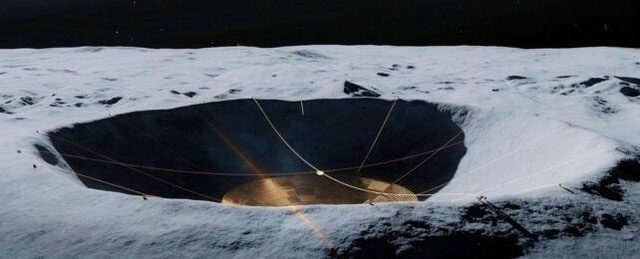An observatory placed on the surface of the Moon would allow humans to conduct many missions to explore the universe in greater detail.
With every advancement in technology, we make new astonishing and surprising discoveries about the universe. So what is our next step in the field of cosmic observation? According to a recent study published on arXiv, the surface of the Moon would be a suitable choice for placing an observatory here.
Essentially, the idea of placing a telescope on the Moon is not new. In fact, NASA has invested a significant amount of money to test the feasibility of the LRCT (Lunar Crater Radio Telescope) project at a lunar crater. During the Apollo missions, astronauts placed retroreflectors on the Moon so that astronomers could measure the distance to the Moon within millimeters.

An observatory placed on the surface of the Moon would allow humans to “see further” into the universe compared to telescopes located on Earth or in orbit around our planet.
While distant radio telescopes like the LCRT may be the most popular proposal, other radio telescopes, including the Lunar Far Side Telescope for Astrobiology (LFTALP), are also considered viable options. This would be a series of radio telescopes with a 6.5-meter wide antenna, focusing on studying the atmospheres of exoplanets as they transit across their stars.
However, the common challenge with all these proposals lies in the technical aspects of construction, which would be a challenge even on Earth. In other words, the idea of building radio telescopes or similar equipment on the Moon is a noble goal, but currently, it far exceeds our technical capabilities.
Therefore, the research team proposed a somewhat simpler idea. A basic optical telescope could leverage the Moon’s terrain. The power of an optical telescope largely depends on the size of the primary mirror and the telescope’s focal length. On Earth, the focal length can be increased by installing multiple mirrors.
Here, a super telescope could use mirror arrays as the primary mirror arranged along the terrain of the crater. The telescope’s detector array could then be suspended by cables, similar to how the detectors at the Arecibo Observatory were suspended above.
Since the mirrors do not need to be large, they would be much easier to manufacture. Meanwhile, the geological characteristics of the crater would also reduce the need for extensive ‘digging’ and facilitate easier placement of the telescope in the correct position.
A variant of this idea is to place the mirror on one side of the crater and the measuring equipment on the other side. This would allow for a very large focal length, but the observational range of such a telescope would be limited.
Overall, all these ideas are still in the early stages. Moreover, there are significant challenges to overcome beyond just construction. For instance, lunar dust will accumulate on the mirrors over time and needs to be removed. And although the Moon has less seismic activity than Earth, it can still affect the alignment of the mirrors and detectors. But one thing is clear: we will return to the Moon in the near future. Once humans set foot on this satellite, a lunar observatory is just a matter of time.


















































